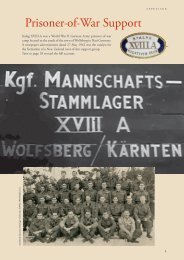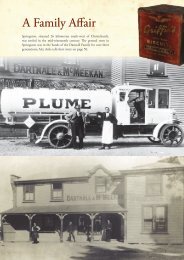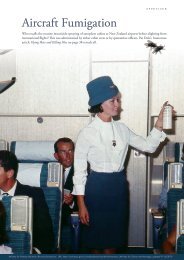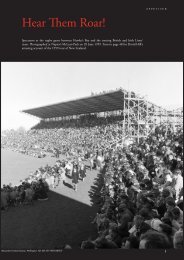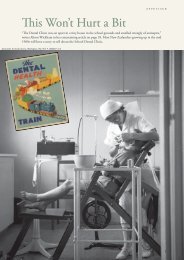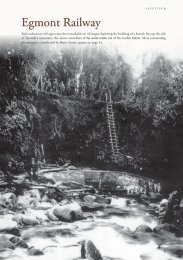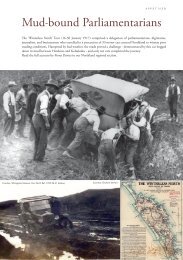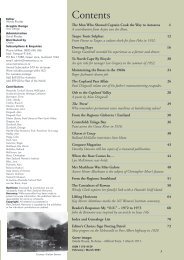New Zealand Memories Issue 149
- No tags were found...
Create successful ePaper yourself
Turn your PDF publications into a flip-book with our unique Google optimized e-Paper software.
APPETISER<br />
Pride in the Job<br />
“Painters in my father’s era were trained in glazing, lead lighting, graining, signwriting,<br />
gold lettering, making and tinting wall-paint, wallpapering and painting” writes<br />
Selwyn Dobbinson. Turn to page 18 for a personal insight into the skills of the trade.<br />
1
EDITORIAL<br />
Dear Readers,<br />
It’s always a pleasure to publish Gordon Campbell’s gems, and his leading article<br />
on the Hardwicke settlement, situated on one of the remote Auckland Islands,<br />
reveals the unimaginable hardships of hopeful immigrants who struggled with the<br />
bitter weather and wild conditions in 1849 before moving on to greener pastures.<br />
Locations selected for some of the Crown Colonies planted in <strong>New</strong> <strong>Zealand</strong> are<br />
unfathomable.<br />
In the last few issues we have featured stories from various tradesmen: a builder;<br />
a fitter and turner; and now a painter and paperhanger. I was astonished at the<br />
broad range of skills required for this trade during the Victorian era. Selwyn<br />
Dobbinson relates his father’s experiences in this field of expertise.<br />
Jeff Taylor’s story of Hamilton Lake will trigger happy memories for many Waikato readers. In other stories,<br />
David Hill may have delivered your Napier newspaper or you may have contributed a penny to Lofty<br />
Blomfield’s ‘penny pile’.<br />
On a more sombre note the story, There are never any reasons given, will give readers a topic to reflect upon.<br />
This true account by Sam Jaffe occurred during World War II and its relevance, in different contexts, continues<br />
today. The article opens up the ongoing discussion of <strong>New</strong> <strong>Zealand</strong>’s refugee criteria and quota and the difficult<br />
decisions it poses.<br />
As we start the journey into the winter months, and hopefully an end to this coronavirus scourge, I wish you<br />
the warmth of love from friends and family.<br />
Wendy Rhodes,<br />
Editor<br />
Phasing out of Cheques<br />
As <strong>New</strong> <strong>Zealand</strong> banks will be stopping cheque payment shortly, the last date for receipt of cheques in our<br />
office will be 14 May 2021.<br />
We are aware that this will cause difficulties for some subscribers. You are welcome to top up your<br />
subscription by cheque prior to this date - $79 for one year and $154 for two years – and we will add the<br />
extra copies onto your current balance.<br />
Do phone our office if we can help in any way.<br />
We will continue to welcome Visa, MasterCard and Internet Banking.<br />
For just $79 you receive an annual<br />
subscription to <strong>New</strong> <strong>Zealand</strong> <strong>Memories</strong>.<br />
Six superb issues direct to your letterbox.<br />
A G i f t o f D i s t i n c t i o n<br />
Surprise a friend or relative with a gift subscription.<br />
We will even gift wrap the first issue, include a gift<br />
card with your personal message and post it direct.<br />
Freephone: 0800 696 366 or<br />
Freepost: 91641<br />
PO Box 17288<br />
Green Lane, Auckland 1546<br />
Email: admin@memories.co.nz<br />
Visit our website w w w.memories.co.nz for subscriptions and gift ideas.<br />
Order online securely today and pay via internet banking, cheque or credit card.<br />
2<br />
Subscribe and Save!
Editor<br />
Wendy Rhodes<br />
Graphic Design<br />
Icon Design<br />
Administration<br />
David Rhodes<br />
Distributed by<br />
Ovato<br />
Subscriptions & Enquiries<br />
Phone tollfree: 0800 696 366<br />
Mail: Freepost 91641,<br />
PO Box 17288, Green Lane, Auckland 1546<br />
email: admin@memories.co.nz<br />
www.memories.co.nz<br />
Annual Subscription $79 for six issues<br />
(Price includes postage within NZ)<br />
Contributors<br />
Albertland & Districts Museum<br />
Alexander Turnbull Library<br />
Anderson, Bruce<br />
Auckland Libraries Heritage Collection<br />
Boswell, Don<br />
Campbell, Gordon<br />
Central Hawke’s Bay Museum<br />
Christchurch City Libraries<br />
Cooper, Wendy<br />
Couch, Cliff<br />
Coyne, J<br />
Creamer, John<br />
Dingwall, Paul<br />
Dobbinson, Selwyn<br />
Fletcher, Ian<br />
Fischer, Libby<br />
Hamilton Central Library Heritage Dept.<br />
Hawke’s Bay Museum<br />
Hill, David<br />
Jaffe, Sam<br />
Jones, Kevin<br />
Lang Thomas, Miriam<br />
Lowe, G<br />
MacKenzie, Alastair<br />
McLennan, Candice<br />
Norsewood Pioneer Museum<br />
Nelson Provincial Museum,<br />
Pupuri Taonga o Te Tai Ao<br />
Queen’s Redoubt Trust<br />
Relph, David<br />
Robinson, John<br />
Sewell, Don<br />
Shields, Ted<br />
Stewart, Graham<br />
Stone, Alex<br />
Tait, Gordon<br />
Taylor, Jeff<br />
Tingey, Robert<br />
Opinions: Expressed by contributors are not<br />
necessarily those of <strong>New</strong> <strong>Zealand</strong> <strong>Memories</strong>.<br />
Accuracy: While every effort has been made to<br />
present accurate information, the publishers take no<br />
responsibility for errors or omissions.<br />
Copyright: All material as presented in<br />
<strong>New</strong> <strong>Zealand</strong> <strong>Memories</strong> is copyright to the publishers<br />
or the individual contributors as credited.<br />
ISSN 1173-4159<br />
April/ May 2021<br />
Contents<br />
Hardwicke – <strong>New</strong> <strong>Zealand</strong>’s Southernmost Settlement 4<br />
Gordon Campbell transports us back to the mid-nineteenth century.<br />
Night Runner 12<br />
David Hill, Napier paper delivery boy.<br />
Country Policing in the 1940s 15<br />
A fishy story recorded by David Relph.<br />
Trade Cards 16<br />
A selection from John Creamer’s card collection.<br />
Pride in the Job 18<br />
The painter and paperhanger’s trade; a story by Selwyn Dobbinson.<br />
Antics at Boarding School 22<br />
Ted Shields was a boarder at Waitaki Boys’ High School.<br />
From the Regions: Whanganui / Manawatu 26<br />
Centrefold: No Shortage of Accommodation at the Lyell 36<br />
“There are never any reasons given” 38<br />
Sam Jaffe records a tragic episode in his family’s history.<br />
Lofty Blomfield and the ‘Penny Pile Fundraiser’ 45<br />
Contributed by Gordon Tait.<br />
Do You Remember the Misses Beresford? 46<br />
By Candice McLennan, a great niece of the music and dance tutors.<br />
Monthly Dances 49<br />
Cliff Couch recalls treading the “light fantastic” in the 1940s.<br />
A Soldier’s Collectibles 50<br />
Written by Don Sewell in conversation with Ian Fletcher.<br />
Colonial Service 54<br />
Wendy Cooper records the Hickling Family’s teaching appointment.<br />
From the Regions: Waikato 56<br />
Mailbox 67<br />
Index and Genealogy List 70<br />
Editor’s Choice 72<br />
Not the one that got away<br />
Cover image:<br />
Hartley Hargreaves with his pet dog.<br />
The Hargreaves Family lived in Oneriri<br />
when this photograph was taken by<br />
Harold Marsh in the early 1900s.<br />
Courtesy: Albertland & Districts Museum<br />
3
ARTICLE<br />
Hardwicke – <strong>New</strong> <strong>Zealand</strong>’s<br />
Southernmost Settlement<br />
Gordon Campbell<br />
An attempt to establish a small, remote Crown Colony<br />
far to the south of <strong>New</strong> <strong>Zealand</strong> was a dismal failure.<br />
Peering through a sudden break in the curtain of fog that blanketed the sea, the settlers on board the<br />
Fancy got their first unpromising view of the islands that would be their new home. They had been<br />
sailing in squally weather through the dense, driving mist for the past four days. Unable to take<br />
observations to confirm his position, but knowing he was in the vicinity of the islands, Captain<br />
Davidson knew his situation was extremely dangerous. He was concerned that his ship could carry on blindly,<br />
missing the islands altogether and sailing on into the landless sub-Antarctic Ocean. There was also the added fear<br />
that the ship could be wrecked on the rock-bound cliffs that lined the island’s western shores. For a few minutes<br />
the mist cleared enough to reveal the South Cape of Adams Island, the southernmost point of the group. The<br />
relief on board was palpable as the ship made its way up the eastern coastline towards their new home.<br />
Alexander Turnbull Library, Wellington, <strong>New</strong> <strong>Zealand</strong> ref:MSX-8008, A-093-008<br />
4
ARTICLE<br />
It was December 27, 1849, and the Fancy was the last of the three<br />
ships to arrive at the new settlement at Port Ross, at the northern<br />
end of Auckland Island. This settlement venture was led by Charles<br />
Enderby. He was the grandson of Samuel Enderby who had<br />
established the British Southern Whale Fishery, the most successful<br />
British whaling firm throughout the late 1700s and early 1800s. By<br />
the 1830s the British whaling industry was in decline and Britain<br />
was becoming more dependent on foreign nations, particularly<br />
America, for its supply of whale oils. To remedy this situation Charles<br />
Enderby promoted the idea of setting up a colony in the Southern<br />
Pacific Ocean to specifically support a whaling industry. Having a<br />
fleet of whaling vessels permanently stationed in the heart of the<br />
whaling seas would avoid the need for the long, expensive voyages<br />
from Britain. From this South Pacific base whaling ships could be<br />
sent out to hunt Southern Right whales, whose oil would be stored<br />
at the station before being loaded onto especially equipped ships for<br />
transport to England. In this way there would always be ships in the<br />
whaling grounds, and oil on its way to England. Enderby envisioned<br />
the colony would be entirely self-supporting. Agriculture and market<br />
gardens would supply a surplus of food, and its location on the Great<br />
Circle trade route between Australia and Britain meant it would be a<br />
convenient port of call to refit and resupply merchant ships.<br />
The Auckland Islands were chosen as the site for a new Crown<br />
Colony that would complement this whaling station. The colonisation<br />
of the islands was to be simultaneous with the development of the<br />
whale fishery. The islands had been discovered by Captain Abraham<br />
Bristow, of the Enderby whaler Ocean in 1806, and the company<br />
had been granted a 30 year lease of the islands for a minimal rental<br />
in 1847. A settlement, named Hardwicke after the Governor of the<br />
company, was planned for Port Ross. Charles Enderby was to be the<br />
company’s Chief Commissioner at Hardwicke and was also given<br />
Her Majesty’s commission as Lieutenant-Governor of the Auckland<br />
Islands. This was to be a planned settlement along the lines of the<br />
“balanced” Wakefield settlements in Wellington, Nelson and <strong>New</strong><br />
Plymouth. A range of trades and professions were represented in<br />
the colonists selected for the initial settlement. As well as a surveyor<br />
and storekeeper, there were doctors, clerks, boatmen, coopers,<br />
shipwrights, carpenters, blacksmiths, bricklayers, masons, farmers<br />
and labourers, providing the necessary skills to help ensure the success<br />
of the tiny, remote new colony. Young married couples were valued<br />
for the permanence and stability they would provide. Overseeing the<br />
establishment of the colony was the Assistant Commissioner, William<br />
Mackworth. Only 24 years old, he was the colonial administrator<br />
who described himself as, “soldier, sailor, judge, lawyer, engineer and<br />
everything else.” 1 He carried out the day to day management of the<br />
enterprise. His diary records a lot of his energy was spent acting as a<br />
mediator between Lieutenant-Governor Enderby and the colonists.<br />
1 McLaren, Fergus The Auckland Islands: Their Eventful History. p.51<br />
Top: Auckland Islands Diary Volume Two, 20 Feb to 23 April 1852.<br />
Barracks on the beach and the buildings of the Southern Whale<br />
Fishery Company’s settlement at Port Ross, 1850 -1852.<br />
5
ARTICLE<br />
A sketch of Lord Auckland’s Groupe, discovered by Abrm. Bristow, 1806 [cartographic material].<br />
Ref: 100aj 1774-1823. Alexander Turnbull Library, Wellington, <strong>New</strong> <strong>Zealand</strong>. /records/20437592<br />
On arrival the colonists were unexpectedly met by a group of Te Atiawa Māori. Led by a chief called Matioro,<br />
seven years earlier they had established several pa around the Port Ross harbour. Matioro was part of the Ngati<br />
Mutunga and Ngati Tama hapū who conquered and enslaved the Moriori inhabitants on the Chatham Islands<br />
in 1835. In 1842 he was part of an expedition of about 40 Ngati Mutunga and 25 Moriori slaves who left<br />
the Chathams on a chartered ship to settle the islands they called Maungahuka. Marooned, with no way of<br />
returning to <strong>New</strong> <strong>Zealand</strong>, they lived a very marginal existence, enduring deprivation and hardship in the sub-<br />
Antarctic climate. The arrival of a hundred European colonists, with their materials and goods, meant that their<br />
lives would be somewhat easier. Although the unexpected presence of Māori initially caused some nervousness<br />
amongst the settlers, relations were generally very positive. Many Māori were employed in road making, as well<br />
as crew on the company’s ships. Matioro, and another chief, Ngatere, were appointed as company constables,<br />
and were instrumental in promoting friendly relations between the two races.<br />
The first few weeks after the arrival were taken up clearing land along the foreshore of Erebus Cove, for gardens<br />
and building sites. Within a few days of arrival, Mackworth identified a major issue that would contribute to<br />
6
ARTICLE<br />
the eventual failure of the settlement when he wrote, “Our greatest enemy in this difficult undertaking is the<br />
weather.” 2 Despite it being mid-summer, gales and perpetual rain slowed down the unloading of building<br />
materials and supplies. Mackworth’s diary is peppered with references to the appalling weather. He constantly<br />
refers to the incessant rain, interspersed with hail and snow, accompanied by ferocious winds that would plague<br />
the islands day after day. One settler, George Crane, said that it rained for six days and blew a hurricane on the<br />
seventh. 3 The colonists lived in damp conditions on board their ships while the prefabricated buildings were<br />
being assembled. Many got sick and complained bitterly during these first weeks before the bachelors’ quarters<br />
and married couples’ cottages were ready to occupy. As Lieutenant-Governor, Enderby moved into Government<br />
House once it was ready. Meanwhile, a cooperage and other workshops were built, and a warehouse erected to<br />
store supplies. A flagpole was erected and a battery of four guns set up to defend the settlement.<br />
Right from the beginning, food supplies were a problem for the settlers. During the first few weeks, the limited<br />
initial supplies of food brought out were strictly rationed. This issue held up the unloading of ships and building<br />
work during the first weeks when a group of colonists went on strike, demanding an increase in their rations. A<br />
few acres of land were surrounded by a shelter fence of stakes and cleared for gardens. The short growing season<br />
and inclement weather weren’t the only hinderance for a continuing food supply. The island’s swampy, acidic<br />
peat soil couldn’t be improved and produced pitiful vegetables. The settlers had to rely on the limited amount<br />
of potatoes and cabbages provided by the Māori community, complemented by irregular supplies of items such<br />
as flour, fresh fruit jam and pickles from the Australasian settlements. Meat was also in short supply. A shipload<br />
of sheep, beef cattle, two cows and three horses (which were never used), had been landed in early 1850, and<br />
were released on Enderby and Rose Islands, the only places with grazable land. Stockyards and a farm cottage<br />
were built on Enderby Island, but the stock became wild and mustering them proved challenging. Mackworth<br />
recorded one attempt to try and kill stock, during a period when settlers had run out of meat. One party on<br />
Enderby Island “passed the whole day endeavouring to get within gun shot of the sheep but without success”. 4<br />
Another group returned empty handed after spending five days trying to kill a cattle beast. On one occasion<br />
2 Mackworth, William & Munce, William Enderby Settlement Diaries. Records of a British Colony at the Auckland Islands 1849 - 1852.<br />
p 22, 10 January.<br />
3 Fraser, Conon The Enderby Settlement. Britain’s Whaling Venture on the Sub-Antarctic Islands 1849 - 52. p66<br />
4 Mackworth Diaries 3 October 1851 p.90<br />
The Astrolabe and Zelee anchored off Shoe Island, a small island of basalt, during Dumont d’Urville’s visit to the Auckland<br />
Islands in March 1840. Alexander Turnbull Library, Wellington, <strong>New</strong> <strong>Zealand</strong> ref: B-052-014<br />
7
EDUCATION<br />
Antics at Boarding School<br />
Ted Shields<br />
Waitaki Boys’ High School is situated a few kilometres north of Oamaru, immediately between<br />
the sea-coast and the Main Trunk Railway Line. There were approximately 260 boarders in<br />
attendance during the early 1950s and, in addition, the school was responsible for the education<br />
of day boys from an extensive area of North Otago. Whilst many past pupils have achieved long<br />
standing responsibilities in society, whether it be with sport or academic positions, this narrative is more about the<br />
mischief which some of the boys, more especially myself and my three mates, would get up to outside of school<br />
hours.<br />
I spent almost two years at Waitaki Boys’ High School as a boarder (1951-1952), which in some ways was an<br />
unique experience, but I would not enjoy repeating it. I was nicknamed ‘Jock’ because, initially, I did not know<br />
any names of the older boys and always responded to an order to ‘fag’ 1 with “OK Jock” – hence the nickname. We<br />
had plenty of fun outside school hours; much being a lot plain mischief by breaking the rules and testing authority.<br />
1 ‘Fag’ definition: a junior pupil at school who does minor chores for a senior pupil.<br />
Author Ted Shields is seated in the second row, fourth from the right, in this 1951 Waitaki Boys High School class photograph.<br />
22
EDUCATION<br />
“Broken biscuits were plentiful; in<br />
those days retailers purchased the<br />
product loose in large square tins.”<br />
Prior to going to Waitaki, motorcycle speedway racing was a popular spectator sport in the<br />
main centres and was carried out on quarter mile cinder circuit tracks. Young boys would form<br />
ad hoc cycle clubs and imitate the speedways by using bicycles. Accordingly, a club was set up<br />
at Waitaki and became extremely popular as a lot of the country boys had never experienced<br />
such an activity.<br />
I took my old bike with ‘apehanger’ handlebars and a box of spares to Waitaki and it was not<br />
long before I obtained permission from the rector to form a track at the back of the school. This<br />
was done on what was known as ‘The Mansions’, a few acres of waste land adjoining the school<br />
property. With a few trees, a bit of scrub and a narrow creek, this was the ideal set up and several<br />
of my mates formed the track with me by using the necessary tools from the gardening shed.<br />
As soon as the track was completed, it was all on. The popularity was phenomenal. After<br />
the evening meal a lot of the boarders would head for ‘Jock’s Speedway’ and race their bikes<br />
on the new track. My bike was stripped bare and it was not long before many others followed.<br />
Within a short time, many previously good bikes were virtually wrecked due to the crashes and<br />
reconstructions.<br />
Military training was part of the school curriculum and we had a double period of military<br />
drill every Wednesday afternoon. Whatever we did was done mainly on the eastern playing<br />
fields where we were exposed to the cold easterly wind that blew constantly in the summer. It<br />
was so cold that we often wore two jerseys. This military drill did not appeal to me. My mates<br />
and I would usually bunk and head for the farm next door and hide amongst the box thorn<br />
whilst sitting out the time on fruit boxes. It was there that we would indulge in smoking until<br />
the time came one day when we were caught. This was followed by three strokes of the cane<br />
from the rector for bunking military drill and then four more straight after from the head<br />
prefect for smoking.<br />
There was an old apple orchard adjacent to the school and from here we would pick apples<br />
and make apple cider. Sugar was accumulated by sneaking leftover sugar from the dining room<br />
tables, The brew was made in beer bottles, which after bottling were buried in the ground in<br />
the native bush so as to be hidden from other ‘brewers’. It was common practice to have your<br />
cider stolen.<br />
Food was always an issue; we were always hungry. On a Thursday boarders were issued with<br />
one shilling (10 cents) pocket money, sometimes more if a ‘reserve account’ was funded by<br />
our parents. It was usual to bike into town on Friday after school and buy food. Often broken<br />
biscuits from Woolworths or else a trip to one of the Tea Rooms to buy some hot buttered<br />
toast. Broken biscuits were plentiful; in those days retailers purchased the product loose in<br />
large square tins. They were not packed, as they are today, leading to breakages which were sold<br />
cheaply. The pieces of broken chocolate biscuits were eaten first of course.<br />
23
36
No Shortage of Accommodation<br />
The township of Lyell, built on a hillside near the Buller River, gradually emerged after the region’s<br />
significant gold discoveries of the 1860s. During the town’s heyday in the latter part of the nineteenth<br />
century, numerous hotels sprung up; a collection can be seen in this c.1890 Tyree Bros. photograph.<br />
In Cliff Street, taken from the Anglican Church at the top of the hill, five hotels can be identified:<br />
The Welcome Inn (foreground), the Post Office Hotel (on the bend, left of Cliff Street), the Criterion<br />
and the Empire (right of Cliff Street - in line with centre of the Welcome Inn’s rooftop) and the large<br />
building (nestled in the hillside at centre) is Sloan’s Alhambra Hotel.<br />
Courtesy: Nelson Provincial Museum | Pupuri Taonga o Te Tai Ao Reference: C1076<br />
The 1910 photograph at left shows a clear view of the Welcome Inn Hotel and Cliff Street.<br />
Alexander Turnbull Library, Wellington, NZ. Ref: 1/2-001206-G.<br />
Reference: Darrell Latham, The Golden Reefs: An Account of the Great Days of Quartz-Mining at Reefton, Waiuta and the Lyell.<br />
37
DANCE<br />
Do You Remember the<br />
Misses Beresford?<br />
Candice McLennan<br />
Some years ago, while travelling in a bus along Auckland’s Symonds Street, I overheard a snippet of<br />
conversation from the seat in front of me. As we passed where Number 106 once proudly stood, I heard<br />
“Do you remember the Misses Beresford, I wonder what happened to them?” In an unusual moment<br />
of serendipity I was able to tap them on the shoulder and provide some answers. Coincidentally, I am<br />
one of the Misses Beresfords’ great nieces.<br />
So who were these two talented ladies? The Misses Beresford were among the leading figures in Auckland<br />
entertainment during the first fifty years of last century. Miss May Beresford taught piano and singing and<br />
Miss Aileen taught dance and violin. Mary Bridget (known as ‘May’) and Aileen Kathleen were born in 1876<br />
and 1884 respectively, sisters to John Benson, Percy James, Bertie Cecil and Leslie Charles. Initially they lived<br />
in Normanby, Taranaki. The family then settled in Whangarei in the mid 1880s where their father, Charles<br />
Henry Beresford, set up and ran a general store along with their mother, Marie Therese. Whangarei is where<br />
May and Aileen received their musical and dance education. They were well-respected performers with their<br />
own orchestra, which toured the North Island giving concerts. Aileen was often asked to judge local dancing<br />
May Beresford in costume in the early the 1900s.<br />
46
DANCE<br />
competitions. In June 1952, May told The Weekly <strong>New</strong>s, “We used to tour everywhere together in a buggy and<br />
the roads were shocking. Sometimes there would be mud up to the axles”. May began to teach music at the age<br />
of 14 to pay for her own lessons.<br />
In the early 1890s the family moved to Auckland. This enabled May to play in orchestras and concert parties<br />
and Aileen to dance and teach. Aileen would dance at the Princess Theatre (later the Plaza Theatre) in the short<br />
ballets that preceded the main film. Often on Sunday afternoons both May and Aileen would entertain patrons<br />
in the Tea Kiosk on the summit of Mount Eden. They lived variously at 106 Symonds Street, 2 Constitution<br />
Hill and 9 Rewi Road in Epsom. Both May and Aileen took in students for piano, violin, ballet and ballroom<br />
dancing in the Old Scots Hall in Symonds Street. After May died in 1954, Miss Aileen continued teaching<br />
in the crypt of Old St Paul’s Church in Symonds Street. Later she taught from her home in Rewi Road. I well<br />
remember her studio in which I would take a secret twirl. It was crammed with mementoes - cards of greeting<br />
and thanks from ex-pupils adorned every available surface. Feathers and faded artificial flowers were tucked<br />
behind framed religious texts. <strong>New</strong>spaper cuttings of past-pupil’s achievements were proudly displayed along<br />
with prominent photos of Michael Joseph Savage, past and current Popes, and various members of the Royal<br />
Family. The odd silver-framed photo of May or Aileen on stage in glamorous costumes showed how stylish and<br />
elegant they were.<br />
As teachers and performers they were involved in a prodigious amount of charity work. They dedicated<br />
themselves to raising money during both wars for welfare relief by organising many concerts, often in the<br />
The cast photograph from a Whangarei production. May is third from left (top row) and a younger brother is in<br />
the bottom right corner.<br />
47
EDITOR’S CHOICE<br />
Not the one<br />
that got away...<br />
This shark was caught at Matakohe by Ken Weber c. 1965.<br />
According to contributor Bruce Anderson, to catch the<br />
1456 lb shark, a chain was put around a 44-gallon drum<br />
and a huge hook was baited with half a sheep. The shark<br />
took the bait and held the drum underwater for a half an<br />
hour before tiring. The contents of the stomach revealed<br />
seven 15lb snapper, an octopus and a stingray. Fishermen<br />
were relieved as the shark had been devastating the nets of<br />
local fishermen for some time.<br />
72




